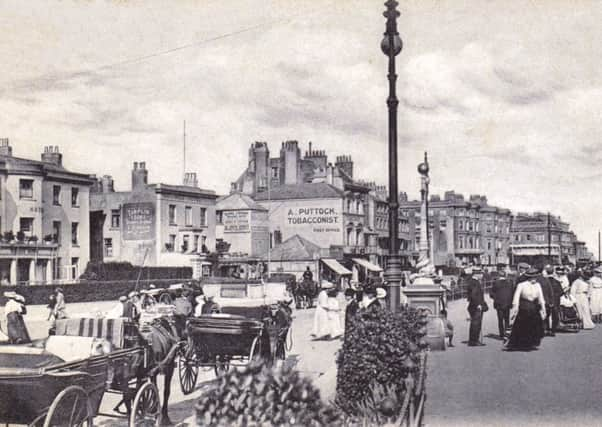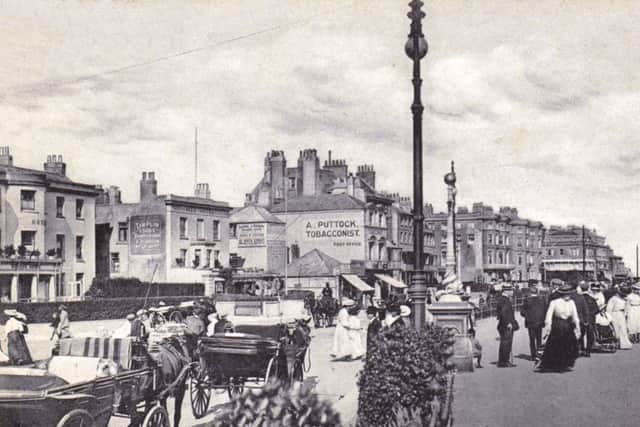Edwardian Worthing in the postcards of the Victoria Series


The company was originally a partnership between Walter Keep and John Davis, two of the most important figures in the history of early picture postcard publishing in Britain; and in 1901 they started producing postcards under the Peacock Brand trademark.
The Peacock Brand became one of the best-selling of all postcard series during the Edwardian age.
Advertisement
Hide AdAdvertisement
Hide AdThousands of views of England and Wales were published, and a few of Ireland; but the firm does not seem to have published any cards of Scotland.


Because the geographical reach of the Pictorial Stationery Company was so wide, it produced fairly few postcards of each location; and there were probably no more than a dozen Peacock Brand cards of Worthing.
In 1902 the partnership between Keep and Davis broke up, and Davis started his own company, producing postcards under the Victoria Series trade-mark.
Unlike the Pictorial Stationery Company, Davis’s firm had a narrow range, almost his entire output consisting of local-view cards of Kent, Sussex, Hampshire and the Isle of Wight.
Advertisement
Hide AdAdvertisement
Hide AdAs a result, Davis produced many different views of most of the locations he covered; and there are at least 80 different views of Worthing in the Victoria Series.
One of the notable features of Davis’s cards is the attractive and instantly recognisable style of the backs.
The earliest cards included the head of Queen Victoria in the logo, but the old queen was soon removed, and the back-style seen on this page is the type that was in use for most of the firm’s existence.
The earliest known postmark on a Worthing Victoria Series card is August 20, 1902, noted by Geoffrey Godden in his book ‘Collecting Picture Postcards’, so it is probable that the firm’s Worthing cards were first available in the summer of 1902.
Advertisement
Hide AdAdvertisement
Hide AdFurther postmark evidence suggests that the firm was at its peak around 1905–6, and it seems to have ceased trading by around 1910, one of many casualties in the competitive world of Edwardian postcards.
The cards in the Victoria Series are among the most attractive local-view cards produced during the first decade of the twentieth century.
Some postcard photographers deliberately came out early in the morning to photograph scenes that were as free of people as possible; and posterity does not thank them for this, because the people and fashions of the time add so much to the character of old photographs.
Victoria Series cards, however – like the slightly later Worthing cards of Lévy Sons & Co, to which they bear a certain resemblance – usually have people in them, adding life and animation to a scene.
Advertisement
Hide AdAdvertisement
Hide AdAs with most other postcard publishers, not all the views on the cards were taken by the firm’s own photographers. Some were bought in from local firms, such as the Worthing Portrait Company.
But it is not just the charm of the original photograph that makes a postcard stand out from the competition.
Almost as important is the quality of a card’s preparation and printing.
In a number of cases, a photograph that appears on a Victoria Series postcard also appeared on cards issued by other publishers – and the Victoria Series version is almost always a finer card than the rival versions.
Advertisement
Hide AdAdvertisement
Hide AdIncidentally, I must apologise to the shepherd featured on the card of the Downs near Findon (bottom right) for suggesting in Looking Back on April 10 that he may have been, for postcard purposes, a jobbing shepherd, whose flock was superimposed on views elsewhere in England.
This Victoria Series card shows that he must have indeed have been a man of the South Downs.
However, his picturesque cap, beard and stick clearly acted as a magnet for postcard photographers, and indeed he may have been something of a local celebrity.
I wonder if any Herald & Gazette reader knows who he was?
• Antony Edmonds is the author of ‘Worthing: The Postcard Collection’ (Amberley, 2013).